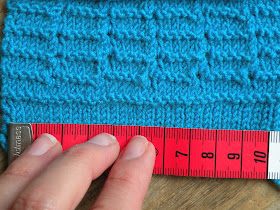
I decided that I wanted to use wool that definitely wouldn't shrink or get out of shape after knitting. Personally, I think that's an ultimate nightmare, when you invested a lot of thinking, woking hours in a piece and then see it get stretched out or shrink after the first time having it washed. When you browse blogs or Ravelry projects, you'll often find that knitters use different types of yarns for vintage projects.
For these projects (actually for anything that is fitted) you shouldn't use cotton or cotton blends as they have less elasticity and tend to stretch out.
Wool for vintage jumpers
My own simple rule: You can use everything that is sold as wool for baby-clothes or as soft sockwool.
'Baby-weight' or 4-ply: 50 g =1,76 oz. is 160-170 m = 170 yds
'Sockwool' or 3-py: 50 g=1.76 oz. is 205 m = 225 yds
I would not recommend to experiment with other wool weights like lace, worsted or dk in order to make your first jumper-projects a success. Remember, if you are using another gauge you should not only resize the patterns all the time, but the drape of the garment could be different as well!For an overview of the standard yarn weights click here. Below is a picture of a few yarns from my stash. Now you see that the 'baby merino' - this is the true baby-weight yarn - looks a bit thicker than the other two, but I knit it up with almost the same gauge because it stretches a bit due to the softness:

I used for my Phillipa jumper the sockwool above: 'Drops Fabel' in shade no.108 'Royal blue' (75% wool, 25% polyamide) 50g=1.76 oz=205m=224 yds. This sockwool yarn feels less elastic as the baby-yarn. The good thing is that it took me less than 5 skeins to knit the jumper! Wow, that's only 250g or 8,8 oz (1025m or 1120 yds)
Gauge or tension
Vintage patterns almost always talk of 'tension' while contemporary patterns speak of 'gauge'. So what is the difference between the two? I turned to my favorite source, the AWW to figure it out:

So the gauge depends not only on the size of needles but also by how you knit: tight or loose. I know of myself that I am a rather tight knitter. I've even knitted a sport weight yarn with metric 3 needles here. But I like the look of it.
I think you should both be satisfied with how your texture looks and feels: It shouldn't be so tight that it gets stiff and loses its drape but shouldn't be so lose that it looks shapeless with giant holes in it.
Back to my jumper (sock)wool:
According to the packaging the gauge should be 26 sts for 10 cm (6,5 sts for 1 inch) on metric 2,5 needles. Well, not for me. I barely managed 28 sts per 10cm (7sts per inch) on metric 3 needles! On 2,5 needles my gauge should be somewhere around the 30 or 7,5 sts per inch. Besides that, I like the look of my gauge! It looks and feels okay. I feel that 26 sts would be way to loose to look pretty. Other than that, loosely knitted garments tend to lose shape and stretch out overtime.
Vintage jumper patterns usually recommend a gauge of 7-7,5 sts per inch this is 28-30 sts per 10 cm (occasionally 6,5 or 8 sts per inch this is 26 or 32 sts per 10 cm) Below my gauge for the 3-ply sockwool and the 4-ply baby wool. As you see, my gauge is almost the same for both yarns. Read the instructions carefully, the gauge or tension is usually measured over plain stocking stitch but sometimes you need to measure your swatch knitted in a pattern (often so with lace patterns). The gauge might be different!


Of course, you need to block your swatch before determining your gauge. Moisture helps to even out your stitches and pulls the yarn in shape. You can either steam with your iron or wet (or wash) your swatch and let it dry. If you are using a 'superwash' treated yarn and plan to wash your garment in the washing machine you should do the same with your watch. Remember: always dry your woolen garments and swatches flat!

did you know that......Orlon was an acrylic yarn? The Dupont Corporation created the first acrylic fibers in 1941 and trademarked them under the name Orlon. It was popular for knitting from the 60's on.Next up: more on re-sizing the pattern and ease!
Previous posts in the Phillipa jumper series:
1. introduction

No comments:
Post a Comment